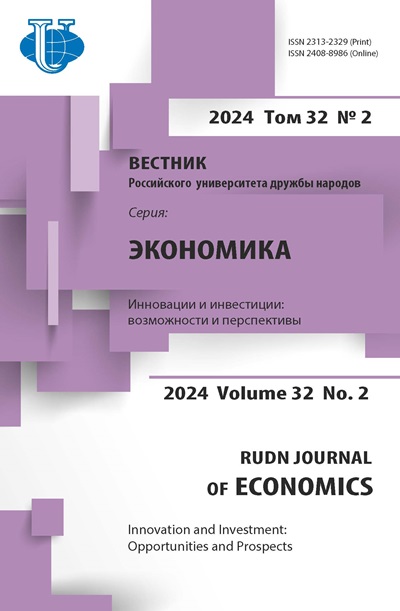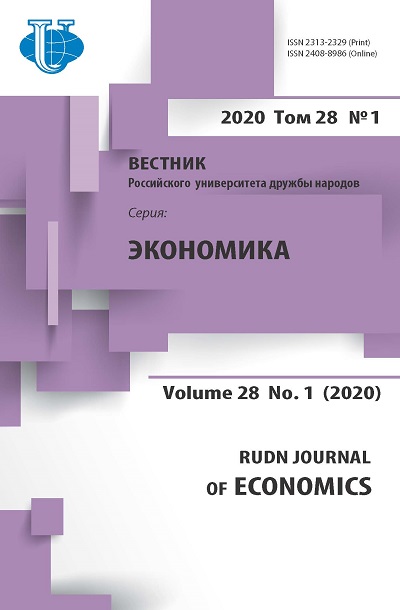Увеличение эффективности фермерских хозяйств в зоне Джиммы, Эфиопия
- Авторы: Легессе Х.1, Бекеле Я.1, Баисса М.1, Лемма Т.2
-
Учреждения:
- Университет Джиммы
- Стелленбосский университет
- Выпуск: Том 28, № 1 (2020)
- Страницы: 7-22
- Раздел: ЭКОНОМИКА ОТРАСЛЕВЫХ РЫНКОВ
- URL: https://journals.rudn.ru/economics/article/view/23489
- DOI: https://doi.org/10.22363/2313-2329-2020-28-1-7-22
Цитировать
Полный текст
Аннотация
В статье анализируются факторы эффективности фермерских хозяйств по производству меда в районах Гомма и Гера зоны Джиммы. Данные были получены от 194 случайно отобранных фермерских хозяйств, производящих мед. Исследование показало, что увеличение количества ульев и дополнительных кормов положительно влияет на урожайность меда. Дальнейшее изучение выявило различия в технической эффективности среди производителей меда в исследуемой области. В результате было установлено, что около 84 % различий в производстве меда среди фермеров объясняется технической неэффективностью. Средний уровень технической эффективности производителей меда составил около 74 %. Это показывает, что существует возможность повысить уровень производства меда примерно на 26 % за счет использования опыта и технических знаний более эффективных фермерских хозяйств. Уровень образования фермеров, владение землей, доход, повышение квалификации являлись определяющими факторами повышения технической эффективности.
Ключевые слова
Об авторах
Х. Легессе
Университет Джиммы
Автор, ответственный за переписку.
Email: yadeta11@gmail.com
Федеративная Демократическая Республика Эфиопия, Клуж-Напока, Почтовый офис, ящик 307
Ядета Бекеле
Университет Джиммы
Email: yadeta11@gmail.com
исследователь, лектор Колледжа сельского хозяйства и ветеринарной медицины
Федеративная Демократическая Республика Эфиопия, Клуж-Напока, Почтовый офис, ящик 307Мулубрихан Баисса
Университет Джиммы
Email: coaes@haramaya.edu.et
заведующий кафедрой экономики сельского хозяйства и управления агробизнесом
Федеративная Демократическая Республика Эфиопия, Клуж-Напока, Почтовый офис, ящик 307Тсега Лемма
Стелленбосский университет
Email: info@sun.ac.za
кандидат наук, кафедра экономики сельского хозяйства
Южно-Африканская Республика, 7602, Стелленбос, Matieland, Private Bag X1Список литературы
- Abdulai, Abdul-Malik, & Abubakari Mohammed. (2012). Technical efficiency of beekeeping farmers in Tolon-Kumbungu district of Northern region of Ghana. Journal of Development and Agricultural Economics, 4(11), 304-310. doi: 10.5897/JDAE12.074.
- Abiyu, Zewdie. (2011, June). An Assessment of Factors That Affect Development Of Beekeeping In Rural Areas: The Case Of Hurumu District, Ilubabor Zone, Oromia Regional State, Ethiopia (Thesis Submitted to the School Of Graduate Studies Of Addis Ababa University In partial fulfillment of the requirements for the degree of Master of Arts in rural livelihoods and development). Addis Ababa, Ethiopia.
- Amanuel, Tadesse, (2011). Value chain and cost benefit analysis of honey production and its implication on household food security: a comparative analysis of certified and conventional honey in GinboWereda, southern Ethiopia (A thesis submitted to the food security studies program of the college of development studies in partial fulfillment of the requirements for the degree of Master of Science in food security studies). Addis Ababa, Ethiopia.
- ATA (Agricultural Transformation Agency). (2014). Annual report transforming agriculture in Ethiopia. Addis Ababa, Ethiopia.
- Chala, K., Taye, T., Kebede, D., & Tadele, T. (2012, March). Opportunities and challenges of honey production in Gomma district of Jimma zone, South-West Ethiopia. Journal of Agricultural Extension and Rural Development, 4(4), 85-91. Retrieved from http:// academicjournals.org/JAERD
- Chala, K., Taye, T., Kebede, D., & Tadele, T. (2013, April). Assessment of Honey Production and Marketing System in Gomma District, South Western Ethiopia. Greener Journal of Business and Management Studies, 3(3), 99-107.
- Chen, C.-F. (2007). Applying the stochastic frontier approach to measure hotel managerial efficiency in Taiwan. Tourism Management, 28(3), 696-702.
- Coelli, T., Rao, D.S.P., & Battese, G.E. (1998). Introduction to efficiency and production analysis. Kluwer Academic Publisher, USA.
- CSA (Central Statistics Authority). (2012). Agricultural sample survey 2011/2012 on livestock and livestock characteristics. Addis Ababa, Ethiopia.
- Ephrem, T. (2013, April). Zonal Diagnosis and Intervention Plan Report for Jimma Zone.
- Farrell, M. (1957). The Measurement of Productive Efficiency. Journal of the Royal Statistical Society. Series A (General), 120(3), 253. doi: 10.2307/2343100.
- Fekadu, G. (2004). Analysis of technical efficiency of wheat production: A study in Machakelworeda (An M.Sc. Thesis presented to the School of Graduate Studies of Haramaya University). Ethiopia.
- Greene, W. (2008). The Econometric Approach to Efficiency Analysis. In H.O. Fried, C.A. Knox Lovell & S.S. Schmidt (Eds), The Measurement of Productive Efficiency and Productivity Growth (chapter 2, pp. 92-250). Oxford University Press, Oxford.
- Ilembo B., & Kuzilwa, J. (2014, July). Technical Efficiency Analysis of Tobacco Production in Tanzania. Interdisciplinary Journal of Contemporary Research in Business, 6(3), 246-265.
- Kebede, H., & Tadesse, G. (2014). Survey on honey production system, challenges and Opportunities in selected areas of Hadya Zone, Ethiopia. Journal of Agricultural Biotechnology and Sustainable Development, 6(6), 60-66. doi: 10.5897/JABSD2014.0232.
- Kuboja, N.M., Isinika, A.C., & Kilima, F.T.M. (2017). Determinants of economic efficiency among small-scale beekeepers in Tabora and Katavi regions, Tanzania: a stochastic profit frontier approach: Development Studies Research.
- Miklyaev, M., Jenkins G.P., & Barichello R.R. (2013). Honey Production in Ethiopia: A CostBenefit Analysis of Modern versus Traditional Beekeeping Technologies. JEL: D13, D31, D61, D62.
- MoFED. (2010). Growth and Transformation Plan (GTP) 2010/11-2014/15. Addis Ababa, Ethiopia.
- Olarin de, L.O., Ajao, A.O., & Okunola, S.O. (2008). Determinants of Technical Efficiency in Bee-Keeping Farms in Oyo State, Nigeria: A Stochastic Production Frontier Approach. Research Journal of Agriculture and Biological Sciences, 4(1), 65-69.
- Olohungbebe, A.S., & Daniel, P.O. (2015). Resource-use Efficiency of Honey Production in Kachia Local Government Area, Kaduna-State, Nigeria. Journal of Agricultural Studies, 4(1), 117-126.
- Shiferaw, K., & Gebremedhin, B. (2015). Technical efficiency of small-scale honey producer in Ethiopia: A Stochastic Frontier Analysis. MPRA Paper No. 69332. Retrieved from https://mpra.ub.uni-muenchen.de/69332/
- Shiferaw, K., & Gebremedhin, B. (2016). Technical efficiency of small-scale honey producers in Ethiopia: A stochastic frontier analysis. LIVES Working Paper 20. Nairobi, Kenya: International Livestock Research Institute (ILRI).
- Tessega, B. (2009). Honeybee Production and Marketing Systems, Constraints and opportunities in Burie District of Amhara Region, Ethiopia (A Thesis Submitted to the Department of Animal Science and Technology, School of Graduate Studies Bahirdar University).
- Tolera, Kumsa, & Dejene, Takele. (2014, May).Assessment of the effect of seasonal honeybee management on honey production of Ethiopian honeybee (Apismellifera) in modern beekeeping in Jimma Zone. Research Journal of Agriculture and Environmental Management, 3(5), 246-254. Retrieved from http://www.apexjournal.org
- Wilson Van Voorhis, C.R., & Morgan, B.L. (2007). Understanding Power and Rules of Thumb for Determining Sample Sizes. Tutorials in Quantitative Methods for Psychology, 3(2), 43-50.
- Yetimwork, Gebremeskel, Berhan, Tamir, & Desalegn, Begna. (2015). Honey bee production trend, potential and constraints in Eastern Zone of Tigray, Ethiopia. Agriculture and Biology Journal of North America, 6(1), 22-29. doi: 10.5251/abjna.2015.6.1.22.29.















